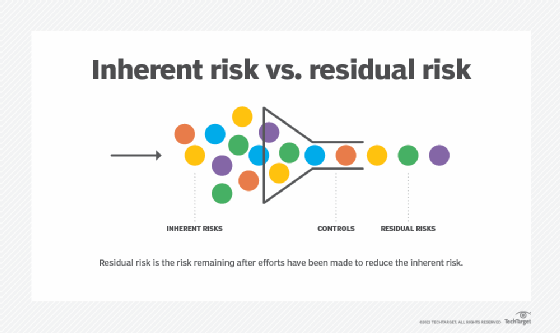What is risk avoidance?
Risk avoidance is the elimination of hazards, activities and exposures that can negatively affect an organization and its assets. Whereas risk management aims to control the damages and financial consequences of threatening events, risk avoidance seeks to avoid compromising events entirely.
While the complete elimination of all risk is rarely possible, a risk avoidance strategy is designed to deflect as many threats as possible to avoid the costly and disruptive consequences of a damaging event.
Risk avoidance is a specific type of approach to managing risk, requiring a methodical process. Leaders must identify and assess the risks their organization faces and determine how they will eliminate the chances of those risks causing damage to the organization.
Because risk avoidance is a deliberate tactic, it isn't the same as failing to identify a risk or ignoring it altogether.
How does risk avoidance fit into a risk management strategy?
Organizations face many different risks; some have the potential to cause significant, widespread harm, while others could cause only limited damage. Risk management is an organizational practice that begins with the following three steps:
- Identify threats to the organization as a whole, including its assets, capital, earnings and revenue.
- Assess the probability of those risks negatively impacting the organization.
- Quantify the damages that could be done by potential risks to calculate risk exposure.
Once the risks are identified and quantified, there are four main risk management strategies, or risk treatment options, that organizational leaders can take to deal with the variety of identified risks:
- Risk acceptance. With this approach, executives decide to accept a risk without taking any actions to mitigate it.
- Risk avoidance. The organization seeks to eliminate the potential risk and the potential for damages and financial consequences of a threat.
- Risk reduction. The organization establishes policies and procedures aimed at limiting a risk from harming the enterprise or limiting the harm done by the risk.
- Risk transfer. Here, the organization contracts with a third party that assumes the risk and its consequences on behalf of the enterprise.
Each of these four approaches has benefits and drawbacks, as well as challenges and costs, associated with how it's designed, implemented and operationalized.
Executives typically weigh the likelihood and negative impact of an identified risk against the respective benefits, drawbacks and costs of the four risk management options. They then choose different options to address different risks. A risk management plan might include the use of all four options.

What are examples of risk avoidance?
Examples of risk avoidance can be found across industries:
- A building company that decides to halt all construction work during an electrical storm to avoid any risk of someone getting hurt is a clear case of risk avoidance.
- A utility company that runs critical systems on an air-gapped network, which is a network completely isolated from all other private and public networks. This approach eliminates the risk of a cyberattack and is a risk avoidance strategy.
- A retailer that doesn't collect and store personal customer data for analysis because it can't meet data privacy regulations is also following a risk avoidance strategy.
The principle of risk avoidance also applies to individual risk.
For instance, investors avoid all risk of losing any of their capital value by placing their assets in a federally guaranteed savings account instead of buying stocks, whose values fluctuate.
Risk avoidance strategies and policies
Business usually balance their risk avoidance strategies with their business goals and objectives. This is done to prevent risk avoidance from limiting growth opportunities. Avoidance strategies are combined with risk mitigation, transfer and acceptance based on an organization's specific circumstances and risk tolerance.
The following are five risk avoidance policies and strategies:
- Activity elimination. This approach involves withdrawal from activities, products or markets that have unacceptable levels of residual risk. For example, a company might discontinue a product line that has significant liability issues.
- Due diligence. Here, an organization thoroughly investigates new ventures, partnerships, markets and investments prior to entering any legal obligations. This approach includes background checks, financial analysis, legal compliance reviews and operational risk assessments.
- Risk transfer. Businesses often use legal agreements, such as indemnification clauses, hold harmless agreements and liability waivers, to shift potential liabilities to other parties. For example, contractors can be required to assume responsibility for workplace injuries occurring during their operations.
- Redundancy and backup. Risk avoidance can involve creating duplicate capabilities to prevent single points of failure. This can involve deploying backup systems, hiring alternative suppliers and developing disaster recovery plans.
- Compliance strategies. Risk is lowered or eliminated by organizations having strict policies and procedures that ensure adherence to laws and regulations. This can include training, monitoring and auditing to prevent compliance issues.
What are the benefits and challenges of risk avoidance?
Like all risk mitigation strategies, the decision to avoid risk has benefits and drawbacks. The pros and cons of a risk avoidance strategy include the following.
Benefits
- Risk avoidance can completely or nearly eliminate a risk that has the potential to damage the organization.
- It also instills confidence that the organization will continue to operate because, with the risk eliminated, it won't have to plan for or contend with the negative consequences associated with the risk.
Challenges
- Risk avoidance can slow operations as employees, business partners and sometimes even customers adhere to the rules implemented to eliminate the risks.
- It can limit opportunities, such as increasing sales, cultivating new customers and developing new revenue streams. For instance, the investors who opt for a savings account do indeed avoid all risk of losing their capital value, but they also miss out on growing those assets more significantly in the stock market. Another example of the downside of risk avoidance is the retailer that doesn't keep consumer data eliminates the risk of running afoul of data regulations but also limits its ability to create a personalized shopping experience that could boost sales.
Risk avoidance vs. other risk management techniques
Risk avoidance and risk reduction are two important parts of a risk management strategy.
Risk avoidance
Avoidance is the only risk management strategy that seeks to eliminate the chance of a particular risk from happening or its ability to affect the organization to any degree. Organizational leaders typically decide on risk avoidance when the risk itself has the potential to inflict catastrophic damage to the organization. In addition, the costs of mitigating the risk can be higher than the benefits of doing so.
To avoid a risk, enterprise executives must design and implement policies, procedures, technology and employee training that support that objective.
Risk reduction
Contrast that with the approach executives take when they decide to accept a risk. Executives typically opt for risk acceptance when the risk's potential to harm the organization is extremely limited or the cost of mitigating the risk exceeds the financial impact it can cause. With risk acceptance, executives take no specific action other than to follow existing practices to address the risk.
Executives take a more moderate approach when pursuing either a risk reduction or a risk transfer strategy. In a risk reduction strategy, executives implement policies, procedures, technology and training aimed at reducing the likelihood or impact of a risk. What remains after the reduction controls are in place, or residual risk, is at an acceptable level.
A risk transfer strategy follows similar steps; however, under a risk transfer strategy, a third party is paid to bear some or all of the costs and consequences if the risk causes harm or damage -- and if it doesn't.

Every piece of an organization's operations is exposed to risks. A larger company needs a risk management team with a mix of executives and managers to manage risks. Find out about the roles and responsibilities of an enterprise risk management team.








